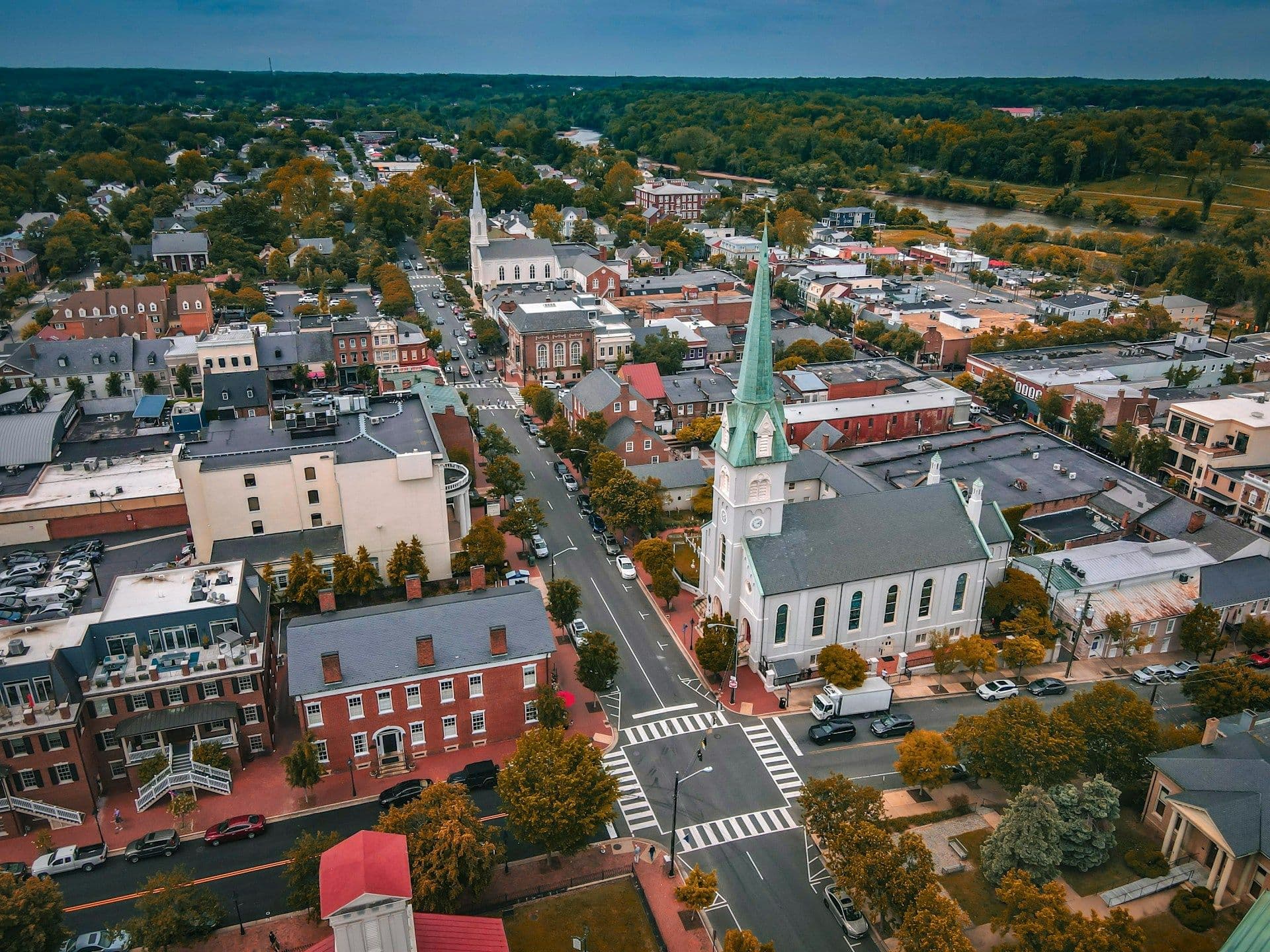
Historic Virginia Journey: Washington, D.C. to Williamsburg
Trip Snapshot
- Distance & Drive Time: ~150 miles one-way (~2.5-3 hours driving). This history-packed route can be done in a long day, but an overnight in Williamsburg is recommended to fully enjoy the sights.
- Best Time to Visit: Spring and fall offer mild weather and fewer crowds. Summer brings long days (but hot temps and more tourists). The Grand Illumination in December and other holiday events make winter visits to Colonial Williamsburg enchanting (though check hours in the off-season).
- Ideal For: History buffs, families with kids (educational fun), road-trippers who love colonial and early American history, and anyone who enjoys interactive living museums.
- Route Summary: From D.C., head south on I-95 through Virginia. Optionally stop in Fredericksburg (50 miles out) for Civil War history, then continue around Richmond via I-295. Join I-64 East to Williamsburg. The return can be via the same route or a scenic alternative (like Route 301) to avoid I-95 congestion.
- Top Highlights: Walking the cobblestoned Duke of Gloucester Street in Colonial Williamsburg amid costumed colonials, standing on the battlegrounds of Fredericksburg and Yorktown, boarding a replica 1607 ship at Jamestown Settlement, and even fitting in some modern thrills at Busch Gardens.
Route Overview
Get ready to time-travel on this drive. Leaving Washington, D.C., you’ll pass from the lands of the Civil War into those of the American Revolution and colonial era all in a single day’s journey. Start early to beat the D.C. traffic on I-95 (hitting the road by 6 AM is wise). The scenery transitions from urban to suburban sprawl, and soon to the greener landscapes of northern Virginia. About an hour in, consider your first stop: Fredericksburg, VA.
Fredericksburg is an unassuming small city steeped in history. If you exit I-95 at Fredericksburg (Exit 130), downtown is just a couple miles away. Park near the Old Town area and stretch your legs along brick sidewalks. Fredericksburg Battlefield (part of Fredericksburg & Spotsylvania National Military Park) is just outside downtown. You can drive the Sunken Road and Marye’s Heights, where one of the Civil War’s fiercest battles took place in 1862, or visit the small visitor center to see exhibits and gaze over the field once charged by thousands of soldiers. It’s humbling to imagine the tumult that took place in these now-peaceful fields and among the quaint antebellum houses (many still scarred by bullet holes). Downtown Fredericksburg itself has colonial roots George Washington grew up nearby so you might also grab a coffee on Caroline Street while admiring 18th-century buildings. It’s a fitting spot to transition your mind from modern DC to the historic journey ahead.
Back on I-95, continue south about an hour toward Richmond. If you’d like a scenic detour, U.S. Route 301 through southern Maryland is an alternative route that crosses the Potomac at the Harry Nice Bridge, then meets I-95 near Richmond. Otherwise, bypass downtown Richmond by taking I-295 around the east side. As you loop past Richmond’s outskirts, consider a quick side trip: St. John’s Church in Richmond (a short drive from I-95) is where Patrick Henry declared “Give me liberty, or give me death!” in 1775. It’s a modest church on a hill if you have time for the short detour, you can stand in the spot of that fiery oration that helped spark the Revolution.
Now head east on I-64 for the final leg to Williamsburg (roughly 50 more miles). You’ll know you’re getting close when you see signs for Williamsburg, Jamestown, and Yorktown these three make up Virginia’s “Historic Triangle.” Take Exit 238 or 234 for Williamsburg, depending on your hotel plans or if you go straight to the historic area.
Arriving in Williamsburg, the clock turns back over 200 years. Begin at Colonial Williamsburg, the living-history museum encompassing the restored 18th-century capital city. Park at the Colonial Williamsburg Visitor Center (free parking); from here you can either walk across the pedestrian bridge or take a quick shuttle ride into the historic district. Suddenly, you’re on Duke of Gloucester Street, often called “DoG Street” a wide thoroughfare of crushed shells and cobblestones, flanked by colonial storefronts, taverns, and the bustle of bygone daily life. Costumed interpreters in tricorn hats and hoop skirts roam about: you might encounter Thomas Jefferson or an 18th-century blacksmith at his forge. Pop into the Governor’s Palace (home of colonial Virginia’s royal governors) and wander its manicured gardens, or step into the Capitol at the other end of DoG Street, where burgesses once debated issues of the day. It’s easy to lose track of time here as a visitor, you’re free to explore the shops (the pewterer, the apothecary, the bookbinder, and more) or even join the crowds if an impromptu revolutionary-era “public protest” or militia drill starts forming on the Green. By midday, you might take lunch at one of the colonial taverns imagine dining on a Brunswick stew or savory pie at Chowning’s Tavern, with servers in period dress and maybe a fiddler serenading the room.
After getting your fill of colonial times, hop back in the car for a short drive (15 minutes) to Jamestown Island, where English America began. There are two complementary sites here: Historic Jamestowne, the actual archaeological site of the 1607 James Fort, and Jamestown Settlement, a living history museum with recreations. If time is tight, Jamestown Settlement (just before the island proper) provides a great immersive overview: you can board replicas of the tiny wooden ships the colonists arrived on, explore a re-created Powhatan Native American village, and walk through a fort model with demonstrations from guides in costume. It’s hands-on and family-friendly kids can try on armor or grind corn. For the history purists, Historic Jamestowne at the end of the island is not to be missed: here, archaeologists have unearthed the real fort site, and you can see the foundations of the earliest church and the resting place of people like Captain Gabriel Archer. The Archaearium Museum displays artifacts like armor, tools, even personal items from those first settlers, offering a tangible connection to the struggles of the New World’s first permanent English colony (1607).
From Jamestown, take the scenic Colonial Parkway toward Yorktown (about 30 minutes drive). The Colonial Parkway is a beautiful winding road with no commercial traffic or development just tree-lined stretches and glimpses of the James and York Rivers. It feels like driving through history, connecting the three sites in a way that modern highways can’t. Arriving at Yorktown Battlefield, you’re at the climactic endpoint of the American Revolution. In 1781, American and French forces besieged the British here, and the surrender of General Cornwallis effectively secured American independence. Stop at the Yorktown Battlefield Visitor Center (part of Colonial National Historical Park) to see Washington’s campaign tent and pick up a map for the self-driving tour. The battlefield auto tour will guide you to sites like Redoubt 9 and 10 (stormed by Alexander Hamilton’s men), the remains of earthen siege lines, and Surrender Field where British troops laid down their arms. It’s a quiet, expansive place; standing by the Grand French Battery, looking out over the fields toward the York River, you can almost hear the distant echo of fife and drum. In the adjacent historic Yorktown village, walk along Main Street where 18th-century homes still stand, and visit the Yorktown Victory Monument, a towering marble commemoration of the victory, erected in 1881 on the battle’s centennial.
By now, you’ve journeyed from the dawn of English America at Jamestown, through the colonial zenith at Williamsburg, to the twilight of British rule at Yorktown truly covering the cradle of the nation. If daylight and energy remain, a fun capstone (especially for kids) is Busch Gardens Williamsburg, a theme park just outside Williamsburg that offers roller coasters and shows amid European-themed hamlets. It’s a modern thrill after so much history perhaps a reward for younger travelers who dutifully trailed through battlefields and museums!
As evening sets, Williamsburg offers plenty of charm for dinner and relaxation whether a ghost tour through the colonial streets (lantern-lit, with spooky tales) or a hearty meal of southern cuisine. Reflect on the layers of history you’ve covered in a single day. From Civil War battle scars in Fredericksburg to the colonial flags of Williamsburg and the revolutionary cannons of Yorktown, this road trip strings together the epic story of America’s past in one unforgettable drive.
Top Stops & Experiences
- Fredericksburg, VA: This colonial town turned Civil War battleground is a worthwhile detour. Visit the Fredericksburg Battlefield (NPS site) where the 1862 battle’s Sunken Road and stone wall still evoke a somber memory of the war’s cost. The Fredericksburg National Cemetery on Marye’s Heights holds thousands of Union soldiers’ graves a poignant hilltop vista over the town. After paying respects, wander Fredericksburg’s historic downtown: browse antique shops and see Georgian-style homes that witnessed battle (many buildings have plaques noting Civil War damage). It’s also a great coffee or lunch stop try a cafe in a repurposed 18th-century building. For Revolutionary War interest, Fredericksburg was George Washington’s boyhood home; you can tour the Mary Washington House or Rising Sun Tavern (once a tavern run by Washington’s brother).
- Richmond’s St. John’s Church (Richmond, VA): If you have time en route, stop at this unassuming hilltop church (circa 1741) where Patrick Henry delivered his famous “Give me liberty or give me death!” speech in 1775. The church often has re-enactors and performances in summertime. Standing in the simple wooden pews where Virginia’s colonial leaders once listened to incendiary words gives you goosebumps, knowing the revolution’s fire was stoked here.
- Colonial Williamsburg (Williamsburg, VA): The crown jewel of this trip. Colonial Williamsburg is the largest living history museum in the U.S. an entire 18th-century city brought back to life. Stroll down Duke of Gloucester Street and engage with blacksmiths, shoemakers, and silversmiths practicing historic trades. Key sites include the Capitol Building (tour the recreated halls of Virginia’s House of Burgesses), the Governor’s Palace (opulent residence with guided tours and an impressive display of period weaponry in the foyer), and Bruton Parish Church (continuously active since 1715). Interpreters throughout might greet you with “Good day!” or debate politics of the 1770s feel free to join the conversation or ask questions; they stay in character! Don’t miss an evening program if staying overnight: options include ghost walks through the creaky old buildings or theatrical reenactments of Revolutionary tales. Colonial Williamsburg covers a large area, but complimentary shuttles make it easy to get around if you park at the visitor center. Tip: If short on time, simply walking the main street (free to the public) and peeking into the shops or taverns gives a great taste. But to go inside the trade shops and exhibition buildings, you’ll need a ticket. It’s worth it for the full experience, especially for families kids love activities like carrying water yokes or marching with wooden muskets in the militia drill.
- Jamestown Settlement & Historic Jamestowne (Jamestown, VA): At Jamestown Settlement (a state-operated museum), 17th-century Virginia comes alive. Board the Susan Constant, Godspeed, or Discovery the trio of tiny ships that carried the English colonists across the Atlantic in 1607 (replicas docked on the Jamestown waterfront). It’s amazing (and humbling) to see how small these ships really were for a transoceanic voyage. On land, explore the Powhatan Indian village where interpreters demonstrate cooking, farming, and building techniques used by Virginia’s native peoples you can even try your hand at grinding corn or scraping a deerskin. Then enter the Jamestown Fort: costumed soldiers fire muskets on schedule, and you can wander through thatched-roof barracks and the governor’s house. This living-history approach makes it easy to imagine the challenges of early colonial life the heat, the mosquitoes, the uncertainty. Just down the road is Historic Jamestowne, the actual site managed by the National Park Service and Preservation Virginia. Here you walk the very ground of the first permanent English settlement in America. The outlines of the original James Fort have been excavated you can stand by the riverbank where John Smith and company built their fort. The site includes the ruined Jamestown Church Tower (circa 17th century) and a statue of Pocahontas, who famously intervened to save John Smith’s life (according to Smith’s account). In the on-site Archaearium museum, see artifacts like tools, pottery, and even human skeletons from the “Starving Time” winter it’s a gritty but powerful window into survival at Jamestown.
- Yorktown Battlefield & Museum (Yorktown, VA): 1781 the victory at Yorktown. Start at the Yorktown Battlefield Visitor Center (NPS), where you can view a short film that sets the stage for the siege. Inside are artifacts like George Washington’s field tent and British General Cornwallis’s sword (a replica of the one surrendered). Then drive or walk to key points: Redoubts 9 and 10, earthen forts captured in daring night assaults by allied troops (one led by the Marquis de Lafayette and Alexander Hamilton). Standing atop Redoubt 10, you’ll overlook the field where French and American soldiers charged through with bayonets a decisive moment that led to British surrender. Another short drive brings you to Surrender Field, a broad meadow where the British army laid down arms on October 19, 1781. A large granite monument, the Yorktown Victory Monument, stands in historic Yorktown village to commemorate the victory it’s an easy walk from the battlefield parking, and from there you get a lovely view toward the York River. Yorktown village itself has charming streets with buildings dating back to the 1700s (like the Nelson House, home of a Virginia patriot). For more context and artifacts (and if time permits), visit the modern American Revolution Museum at Yorktown (near the battlefield, operated by the state) which has extensive exhibits and another living history area with a Continental Army encampment and 1780s farm.
- Colonial Parkway: Not exactly a “stop,” but the drive along Colonial Parkway between Jamestown, Williamsburg, and Yorktown is an experience to savor. The parkway’s roadbed is paved with a special brown pea gravel concrete, giving it an old-time look. It runs about 23 miles with no stoplights or commercial signs. You’ll pass wooded inland sections and then run alongside the York River with pull-offs for views. If you packed a picnic, there are riverside spots to enjoy it. The absence of development along the parkway makes it feel like you’ve truly left the modern world behind a deliberate design so travelers could move between these historic sites in a consistent, reflective environment. Roll down the windows, and enjoy the breeze carrying the scent of pine and tidal marsh.
- Busch Gardens Williamsburg (Williamsburg, VA): For a change of pace (and to please thrill-seekers or kids on the trip), Busch Gardens is a popular theme park just a 10-minute drive from Colonial Williamsburg. The park is divided into European “countries” (England, France, Germany, etc.) and features world-class roller coasters (Griffon, Apollo’s Chariot, and Verbolten to name a few), as well as gentler rides and shows. It’s consistently rated one of the most beautiful theme parks expect lots of landscaping and even Clydesdale horses trotting about in the “Scotland” area. After a morning of historical touring, an afternoon of rides and funnel cake might be a welcome diversion, showcasing Virginia’s fun side. During fall, Busch Gardens hosts “Howl-O-Scream” (a Halloween event), and in December, it transforms into “Christmas Town” with millions of lights. If you can fit it in, it’s a memorable addition to the trip (though plan on spending at least 3-4 hours minimum to get your money’s worth).
Where to Eat & Stay
- Where to Eat: One of the joys of this journey is eating both through history and in the modern day. In Williamsburg, dining can become part of the colonial experience. Try a historic tavern in the heart of Colonial Williamsburg King’s Arms Tavern is a standout choice. Established in 1772 and restored to candlelit colonial splendor, King’s Arms serves 18th-century inspired fare (think peanut soup, game pie, roast meats) in an atmospheric setting of pewter dishes and servers in period attire. It’s not just a meal, but theater for the senses you truly feel like a colonial citizen stopping in for supper. For a lighter or quicker bite, Josiah Chowning’s Tavern offers casual pub fare and often has live colonial music and games in the courtyard (fun for families). Outside the historic area, Mercury Bar & Grill or Food For Thought are popular local spots in Williamsburg offering everything from burgers to crab cakes, for when you want modern cuisine. If you stopped in Fredericksburg for lunch on the way down, consider Mason-Dixon Café (comfort food) or Benny’s Vitali (famous for huge pizza slices) in downtown Fredericksburg. In Yorktown, after touring the battlefield, you can enjoy seafood with a view at the Riverwalk Landing area there are a few waterfront restaurants where you might indulge in fresh Chesapeake Bay oysters or a crab cake sandwich. And don’t forget to grab some homemade fudge or ice cream from shops in Colonial Williamsburg or at the Yorktown Riverwalk as a road snack!
- Where to Stay: To truly immerse yourself in Williamsburg’s ambience, spend a night at one of the Colonial Williamsburg official hotels. The Williamsburg Lodge (an Autograph Collection hotel) is a fantastic choice it’s walking distance to the historic area, and blends modern amenities with colonial-inspired decor for a comfortable stay in the heart of history. Guests at official CW hotels often get perks like discounted admission tickets. For a splurge, the Williamsburg Inn (a five-star property) offers luxury and tradition it has hosted Queen Elizabeth II and other dignitaries, with elegant colonial rooms overlooking a golf course. If traveling with kids, the Great Wolf Lodge Williamsburg is a hit it’s a bit outside town but features an indoor water park and family suites (a fun way to unwind after days of historical touring). Prefer something cozier? Williamsburg and nearby Jamestown Road have several B&Bs in colonial-style homes e.g., Fife & Drum Inn, right in downtown Williamsburg, offers boutique rooms themed to local history. For those on a budget, chain hotels along Richmond Road or near the Outlet Mall provide affordable, comfortable lodging within a short drive of the attractions. And if you want a dose of 18th-century authenticity, you can even book a Colonial House in the historic area yes, you can actually stay in one of the centuries-old homes overnight (with modernized interiors), waking up to the sound of horse-drawn carriages clip-clopping past your door!
Practical Tips
- Beating Traffic: Northern Virginia traffic on I-95 is notoriously congested, especially during weekday rush hours. Aim to depart Washington, D.C. before 6:00 AM to cruise out with minimal delays. If you leave later in the morning, consider using the Express Lanes on I-95 (E-ZPass required, variable toll) to save time around bottlenecks. Alternatively, Route 301 can bypass some I-95 traffic if there are major delays it’s a bit slower with stoplights, but more scenic crossing the Potomac. Coming back north, time your return to avoid hitting D.C. in the late afternoon/early evening rush.
- Time Management: It’s easy to underestimate how much there is to see. If doing this as a day trip, pick one or two major sites to focus on (e.g., Colonial Williamsburg and a quick look at Jamestown), and accept that you’ll save the rest for next time. If you can stay overnight, you’ll have the evening and next morning to expand your explorations highly recommended. Generally, allocate at least 3-4 hours for Colonial Williamsburg (more if you want to tour many buildings or watch multiple interpreter programs). Jamestown Settlement can be done in 1.5-2 hours (similar for Historic Jamestowne). Yorktown battlefield driving tour takes about 1 hour, plus time at the museum. Busch Gardens is a half to full day on its own. Prioritize what interests you most, and be realistic. It’s better to thoroughly enjoy a couple of sites than to rush through all of them.
- Tickets & Passes: Many sites have admission fees. Colonial Williamsburg requires an admission ticket to enter most buildings and see demonstrations (the streets are public). You can buy tickets at the Visitor Center or even online beforehand. Look into combo tickets like America’s Historic Triangle Pass, which covers Colonial Williamsburg, Jamestown (Settlement & Historic), and Yorktown (museum & battlefield) for seven days a good value if you plan to see it all. The National Park Service portions (Historic Jamestowne and Yorktown Battlefield) have separate fees, but if you have a National Parks Pass, those sites are included. Busch Gardens tickets are separate and often cheaper online in advance.
- Guided Tours vs. Self-Guided: In Williamsburg and Jamestown, feel free to explore on your own the sites are well-signed, and costumed staff are very approachable for questions. However, consider joining a guided tour for key sites to enrich your understanding. For example, the Governor’s Palace tour in Williamsburg is led by a guide and really brings the house to life with stories of royal governors. At Yorktown Battlefield, NPS ranger tours (when available) or the audio driving tour CD can greatly enhance the experience by explaining siege tactics and pointing out subtle landmarks. If you’re a Civil War buff, Fredericksburg Battlefield has an excellent 30-minute walking tour from the visitor center led by rangers that covers the bloody assault on Marye’s Heights highly recommended if timing aligns.
- Heat & Weather: Summers in Tidewater Virginia are hot and humid. Daytime highs in July-August often exceed 90°F (32°C) with humidity over 70%. If visiting in summer, dress in light, breathable clothing, wear a hat, and apply sunscreen. Stay hydrated carry a water bottle (many sites have water fountains). Duck into air-conditioned exhibits periodically (the museums at Jamestown/Yorktown, the visitor centers, etc.) to cool off. Thunderstorms are common in late afternoon, so pack a small umbrella or poncho. Conversely, spring and fall can be quite mild and pleasant, but check forecasts and bring a light jacket for cool evenings. Winter is off-peak: sites have shorter hours and fewer programs, but you’ll find thin crowds. Just bundle up; it can get surprisingly chilly with damp air near the rivers.
- Dining Logistics: If you plan to eat at a Colonial Williamsburg tavern, make reservations if possible (especially for dinner or weekends) they are popular and can fill up. Same for nicer restaurants in the area. However, if you’re flexible and don’t mind eating at odd times, you can often walk in for lunch. Outside of that, there are plenty of casual eateries along Richmond Road in Williamsburg (where many hotels are) for a quick bite. While driving, rest stops on I-95 at Dale City (after Woodbridge, VA) and Virginia Welcome Center near Fredericksburg are convenient for bathroom breaks and info brochures. Once on I-64 approaching Williamsburg, there’s a welcome center near New Kent. Always good to keep some snacks in the car traffic or an unexpectedly long museum visit can delay meals.
- Overnight Tips: If you stay overnight in Williamsburg, you’ll get to enjoy the town in the quieter evening hours. The historic area is especially magical at night with lamps aglow and fife and drum performances some evenings. Many hotels in Williamsburg offer packages that include attraction tickets inquire about deals. If you overnight, also consider visiting Williamsburg’s Merchants Square (next to the colonial area) in the morning for boutique shopping and perhaps a pastry at The Cheese Shop or Blackbird Bakery before hitting the road again.
- Flexibility and Detours: This journey offers a lot of potential detours and sometimes the best experiences are unplanned. If a sign for “Washington’s Birthplace” (near Colonial Beach off Route 3) or “Berkeley Plantation” along the James River piques your interest, and you have time, go for it! Virginia is full of historic sites. Just keep an eye on the clock if you have to return the same day. On the flip side, be prepared to skip something if you find yourself enjoying one site longer than expected. It’s okay not to see everything. You can always come back after all, history isn’t going anywhere.
Rentals & Logistics Hitting the Road to History
For this trip, having your own set of wheels is essential it grants you the freedom to hop off the interstate and explore charming detours at will. If you’re visiting D.C. and need to rent a car, choose comfort and space since you’ll be logging a few hours of highway driving. An SUV or mid-size car will easily accommodate any souvenirs (or colonial tricorner hats) you collect along the way. Traffic Tip: Consider renting a car equipped with E-ZPass or toll capabilities. Virginia’s I-95 Express Lanes and some bridges use electronic tolling; an E-ZPass can save you time (and stress) bypassing congestion, even if it adds a few dollars of tolls. When planning your rental pickup, try a location in southern DC or Northern Virginia to avoid city traffic at the start but if that’s not convenient, don’t worry, just schedule an early pickup and departure. Most major rental companies serve the DC area; book in advance to snag the best rate and vehicle type. Reserve the perfect vehicle for your journey and get ready to cruise through centuries from colonial capitals to battlefields all at your own pace. And one more thing: have some good tunes or audiobooks on hand. Perhaps the Hamilton soundtrack for the ride into Yorktown? It’s the ultimate way to get pumped as you roll into the victory town where “the world turned upside down!”
Our Most Popular Vehicles



